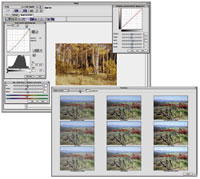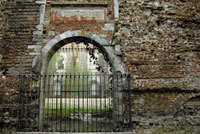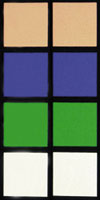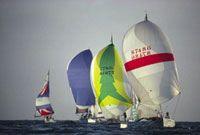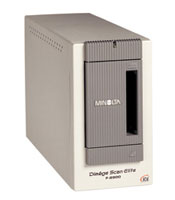Minolta Dimâge Elite
Minolta's newest 35mm (and APS) film scanner, the Dimâge Elite, combines well established basic scanner design with the addition of Applied Science Fiction Digital ICE and new software features. At a street price of under $1000 this new Minolta package offers photographers strong functionality in every dimension, including clean, high quality scans achieved with great efficiency. These strengths include 2820dpi scan resolution, a high 3.6 dynamic range, 12 bit per channel scanning with 24 and 36-bit output options, a multi-sampling option, color matching to the colorspace of your image-editing environment, and automatic and manual scan adjustment options. Then combine a fast preview and final scan speed, plus image cleaning with Digital ICE, with an equally fast functioning software processing package, and you have quality output and efficiency. The Minolta Dimâge Elite's physical package is quite compact and upright using little desk space. The interface is SCSI 2 and the scanner supports use with Windows PCs (95 through 2000) and G3 and later Macintosh platforms. The software package includes a stand-alone scanning utility, as well as a TWAIN driv-er for Windows and a Photoshop plug-in for Macintosh. The Elite is bundled with Photoshop 5 LE. |
|||
Testing The Minolta Dimâge Elite. Since this latest Minolta scanner now comes with ASF Digital ICE, a large part of the extensive selection of images from my library including relatively old slides and color negatives--with many of the slides roughly handled--became ideal images for test scans. I also scanned 40 new Ektachrome slides which were provided to a friend by a colleague, as well as some of the Supra 100, 400, and 800 film I was testing concurrently with this report. I connected the scanner to my Macintosh G3 and installed the software easily and quickly, and had a preview scan on screen in just minutes. I began my scanning with the stand-alone software utility, but was discouraged by the results I obtained relative to what I expected from the preview, even though I carefully checked my setup of the scanner preferences and my Colorsync settings. So I moved to using the Photoshop plug-in. Working within Photoshop provided a tighter relationship between what I adjusted to in the scan preview window, and what resulted in a final scan opened in Photoshop's workspace. |
|||
The Minolta Dimâge Elite software offers an unusual mix of automated adjustment and manual tools. You can set the autoexposure adjustment (AE-Lock/Area) "window" to just part of the image area for instance. This is a distinct advantage with some image types like portraits where you want the adjustment to be concentrated on a central subject and background differences ignored. The driver interface is also adjustable in size to any monitor resolution and desired area of screen real estate. There are four pop-up dialogs for image adjustment, the first being Tone Curve & Histogram that provides for setting the gamut manually or automatically, selecting the highlight, mid-tone, and shadow points with an eyedropper (which supports color caste removal), and adjustment of the image characteristic curve. Next is a Brightness Contrast Color Balance dialog. This is less effective because once the gamut and curve are set they are not locked and any change to brightness and contrast shifts the position of the gamut high and low point settings. Use of the RGB slider is for most users difficult to adjust color balance because it is not visually intuitive. However this is made up for by a Variation Dialog box. But again if image values are adjusted by this easy, comparative thumbnail method, you need to go back to the Histogram and check if your adjustments have altered the selected gamut before making a final scan. Also, for those who choose to do so, you can simply set the output to 12 bits per RGB channel (36-bit RGB), and color correct in Photo-shop in 48-bit Mode. As I suggested earlier a good portion of my test film selected for scanning was old slides and color negatives that would provide an opportunity to evaluate Digital ICE. I even tried using ICE with a couple of Kodachrome images even though it is not supported, and found that ICE did some cleaning making the hand retouching easier. For black and white (gray scale scan setting) Digital ICE is disabled. However, chromogenic black and white films processed in C-41 chemicals can be cleaned when scanned, if you scan them as a color negative and then either desaturate afterward or convert the file to 8 or 12-bit gray scale. Digital ICE worked quite effectively on C-41 black and white, as did the cleaning with all of the dirty old film I scanned including some E-4 and C-22 process films. |
|||
With the color negative films I was also positively impressed with how well the Minolta Dimâge Elite software did interpreting even some odd films like 3M Color Negative and Konica 200 Portrait, providing a good interpretation of the color without requiring excessive color adjustment manually to obtain good fidelity with the subjects photographed. Finally, I never found a need to use the multi-pass scanning option even with Koda-chrome slides as the 3.6 dynamic range of this scanner reproduced dark tones cleanly, free of any noise in the shadows. Evaluation And Recommendation. With the addition of ASF Digital ICE and evolutionary improvements to their hardware and software, Minolta has produced an exceptional device for outputting clean, high quality scanned images in a very affordable package. The only faults I could find are minor inconveniences. For instance, I would gladly give up a little desk space if the scanner were long enough to accommodate a four slide or six negative carrier that didn't have to be flipped and re-inserted for half of the scans. Putting a "lock" on the Histogram high and low points once the gamut was set, would also be advantageous. As I said minor faults probably not everyone would find significant. |
|||
What was very significant from my perspective was the fact the entire process is quite speedy and efficient, not just the scan speed. Even with Digital ICE turned on all of the time, the Minolta Elite is one of the most productive scanners I've used. This makes the Minolta Dimâge Elite the best overall 35mm film scanning choice from every perspective, especially at the under $1000 street price. Now, how about an "Elite" Elite with FireWire and 4000dpi, and blow everyone away? For more information on the Minolta Dimâge Elite 35mm and APS film scanner, contact Minolta Corporation, 101 Williams Dr., Ramsey, NJ 07446; (201) 825-4000; fax: (201) 423-0590; www.minoltausa.com. |
|||
Technical Specifications
|
